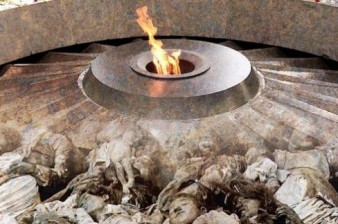
30/04/2015 09:11
Recalling the lessons of Armenia. Genocide of 100 years ago is recurring, now in the Middle East
By Clifford D. May. Washington Times
Displayed outside the Turkish embassy in Washington last week was a large banner reading, “Armenian genocide is an imperialist lie.” That claim might be amusing were the subject not so dreadful. The slaughter of hundreds of thousands of Armenians in 1915 was carried out by the Ottoman Empire. It was, therefore, by definition, an imperialist crime, one regarded by most experts as the first genocide of the 20th century. The notion that some other empire (which one?) has fabricated a slander against Turkey is ludicrous. Those who came up with that slogan must assume they are addressing a clueless audience.
One place to find clues is Efraim Karsh’s “Islamic Imperialism: A History,” published in 2006 by Yale University Press. Mr. Karsh notes that in the last quarter of the 19th century, a weakening Ottoman Empire (which was also an Islamic caliphate) was being “forced to give up most of its European colonies.” At about the same time, the empire’s Armenian population — Christians, whose rights were limited by their Muslim rulers — began to undergo a “nationalist awakening.” Uprisings followed. “In a brutal campaign of repression in 1895-96, in which nearly 200,000 people perished and thousands more fled to Europe and America, Armenian resistance was crushed and the dwindling population cowered into submission.”
A few years later, however, nationalist aspirations resurfaced. Under European pressure, the Ottomans accepted a proposal for limited Armenian autonomy, “a far cry from the Armenians’ aspirations for a unified independent state” but a significant gain nonetheless. When the Ottoman Empire entered World War I, most of its Armenian subjects took pains to demonstrate their loyalty. But a minority became revolutionaries, offering assistance to the Russians, confirming “the Ottoman stereotype of the Armenians as a troublesome people.”
In reaction, Armenians were “uprooted from their homes and relocated to concentration camps in the most inhospitable corners of Ottoman Asia. The Armenians’ towns and villages would then be populated by Muslim refugees, their property seized by the authorities or plundered by their Muslim neighbors.”
Armenians were ordered to give up their weapons. Those “who could not produce arms were brutally tortured; those who produced them for surrender were imprisoned for treachery and similarly tortured; those found to have hidden their arms were given even harsher treatment.”
By 1915, with the Armenian population disarmed, “the genocidal spree entered its main stage: mass deportations and massacres.” At times, “the Turks attempted to preserve an appearance of a deportation policy, though most deportees were summarily executed after hitting the road.” Ottoman authorities sent others “out to sea, ostensibly to be deported, only to be thrown overboard shortly afterward.”
There were many Armenian towns in which all the men were exterminated, leaving the women to be raped. In addition, “thousands of young Armenian women and girls were sold” in newly established “slave markets.” Estimates of the total number of Armenians murdered over a period of more than two years range from 850,000 to 1.5 million.
In the early 1920s, in the aftermath of World War I, the defeated Ottoman Empire and Islamic caliphate were dissolved. The Republic of Turkey rose from its ashes. A strong argument can be made that it bears no responsibility for the crimes committed by the imperialist state it replaced.
On the other hand, modern Turkey continues to occupy Armenian lands. Mount Ararat, where, according to legend, Noah’s ark came to rest after the great flood, is Armenia’s holiest site and a symbol of the nation. It can be seen from Armenia’s capital, Yerevan, among the world’s oldest continually inhabited cities. But Mount Ararat rises from territory now claimed by Turkey.
Ironically — one also might say hypocritically — Turkish President Recep Tayyip Erdogan rails at Israel for its “occupation” of Gaza, and the West Bank. Those territories were under Ottoman rule for centuries. They fell to the British following the Ottoman collapse. In 1948, Egypt seized Gaza, and Jordan seized Judea and Samaria, which it renamed “the West Bank.” In a defensive war in 1967, Israelis took control of both. Since then, they have repeatedly offered to help Palestinians establish their own state on these lands in exchange for peace. Palestinian leaders have declined. And Gaza, from which Israelis withdrew 10 years ago, is ruled by Hamas, a terrorist group openly committed to exterminating Israel.
Today, a jihad — one that includes persecution, enslavement and slaughter — is again being waged against Christians throughout much of the Middle East and in Africa as well. Many of those carrying out these crimes consider themselves warriors of a new caliphate. The mainstream media has mostly avoided discussing the Armenian genocide as preface and precedent. But the media also has been reluctant to report on the very real possibility that we are now witnessing the final, historic eradication of ancient Christian communities from what we have come to call the Islamic world.
Another poster displayed at the Turkish embassy calls for “reconciliation” with Armenia. Surely, such a process must begin with truth-telling. What Mr. Erdogan declared last week instead: “The Armenian claims on the 1915 events … are all baseless and groundless.”
Final point: In 1939, a generation after the Armenian genocide and a week before invading Poland, Hitler gave a speech to his commanders. He told them that his “war aim” was not merely territorial. Nazi Germany also sought “the physical destruction of the enemy.” He recognized that “weak Western European civilization” would not approve. But, he added, it will forget: “Who, after all, speaks today of the annihilation of the Armenians?” That’s just one of several reasons we should continue to do so.








